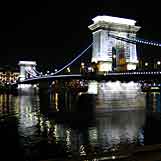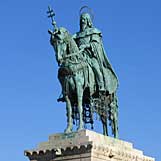Sightseeing in Budapest


Budapest Chain Bridge
Budapest, Hungary
Budapest is the thriving capital city of Hungary with about 1.8 million people. This beautiful city deserves at least 3 nights to see her top sights but you can easily enjoy 4 or 5 nights in the "Queen of the Danube."
Below you will find general information to help you plan and enjoy a trip to this fascinating city. We've include a general recap of Budapest's history and also information about taxis, public transportation and the Budapest Card.
Budapest History 101
About 2000 years ago the Romans founded a settlement called Aquincum and built Roman baths with the natural thermal springs in the area.
In the year 896 AD, seven ancient Hungarian tribes came from the Ural Mountains (Russia today) and conquered the land. The leaders of these seven tribes chose the area (now Budapest) to be the center of their kingdom. In the centuries that followed, "Buda" became the royal residence and "Pest" a trade center.
Hungary's first king, St. Stephen, founded the Hungarian State in the year 1001 and brought (by force and with political reasons) Christianity to the people.
King Matthias is considered the greatest Hungarian king. His father fought successful fights against the Ottoman Empire allowing Matthias to have a great Renaissance Court and a powerful and rich country.
The Turks attacked Hungary in 1526 and occupied much of the country. For over 150 years the Hungarians stopped the Turks from heading further west into Europe. In 1686 a unified European Christian Army recaptured Buda.
In the 18th and 19th centuries, the Habsburgs (from Vienna) ruled the country and brutally repressed two uprising attempts. In the end of the 19th century the Austro Hungarian Empire was formed.
Buda and Pest were first connected by the chain bridge in 1849. But it was not until 1873 that three cities (Buda, Old Buda and Pest) were joined to become Budapest, the capital of Hungary.
In 1896 a grand exhibition was held to celebrate the one-thousand year anniversary of the Hungarian conquest. To prepare for this event, the city park was built, along with many monuments, boulevards and even European Continent's oldest underground tram line. Today, many tourist sights are from this period.
As a result of the WWI peace treaty, Hungary lost nearly two-thirds of its territory and more than half of its population. Today, millions of ethnic Hungarians live in nearby countries.
During WWII, Hungary helped Germany in hopes of regaining some of its lost territories. In 1945 the Red Army liberated the people of Hungary from the Nazis and a communist regime ruled for 40 years.
In 1956 there was an uprising that was oppressed by the Soviet Army and thousands were jailed or executed. Then in 1989 another peaceful uprising which brought true change and a democratic state was formed in 1990.
Hungary joined the European Union in 2004 and will use the Euro as its official currency starting in 2010.
Currency
Until the year 2010 the Hungarian Forint (HUF) is the official currency. Some businesses may accept Euros or even US Dollars but they are not required to do so. One US Dollar buys about 200 Forint (HUF) and one Euro buys about 250 Forint (HUF).
Public Transportation
Budapest has a modern Metro, an extensive tram and bus system, and the historic underground tram. You can purchase single ride tickets or passes that are valid for one, three or seven days. These can be purchased at the metro stops and news stands. An honor system is in place for single tickets so validate the ticket by punching it in the validation box. Ticket controllers can appear randomly, especially on the metro line, and a hefty fine is given if you do not have a validated ticket, pass or Budapest Card. The public transportation is safe, but like any major city, be aware of pickpockets.
If you are arriving in Budapest by train, you can take the Metro into downtown. If you arrive at the Nyugati station you can take the blue metro line and if you arrive at the Keleti or Déli stations, take the red metro line.
Taxis
Because of problems with scams, it is very important to note that you always confirm a price before agreeing to a taxi ride. The most reliable company is called "City Taxi" and you can ask for them by name. At the airport, a reliable company is the "Tourist Taxi".
You should not pay more that 6500 HUF for a transfer from the airport to your hotel in the city. From the train station to a downtown area hotel a reasonable fare is 2500 HUF. For flights and trains coming into Budapest there are usually shuttles offered to hotels. These shuttles cost about the same as taxis and make multiple stops. Some people feel more comfortable with these arrangements as opposed to haggling with a driver.
Budapest Card
The Budapest Card can be purchased at the tourist office and in most hotels. The card is valid for 48 or 72 hours and gives you full access to public transportation within the city, plus free entry into many museums, discounts at other museums, shops and restaurants.
Please also visit the following pages. We have divided the top sights into three categories, those on the "Buda" side, those on the "Pest" side and Day Trips from Budapest.
Travels with Friends: Learn more about other European destinations and tips for traveling within Europe. www.TravelsWithFriends.com
Private Guides: See Europe and learn about its history with your own private guide. www.PrivateGuidesInEurope.com

Budapest St. Stephen
Europe travel news sent to you 15 times a year.
Top sights, hotel reviews, travel tips and more.
Private Tours in France, Greece, Italy and Spain.
Join one of our small group Europe tours.
Tours and day trips to help you explore Europe.
Hire a professional from Private Guides in Europe.
Let us help personalize your European itinerary.
Our thoughts on how to best travel in Europe.
For more information or to send us an email.
Car Rentals, Flights, Hotels, Rail Passes
